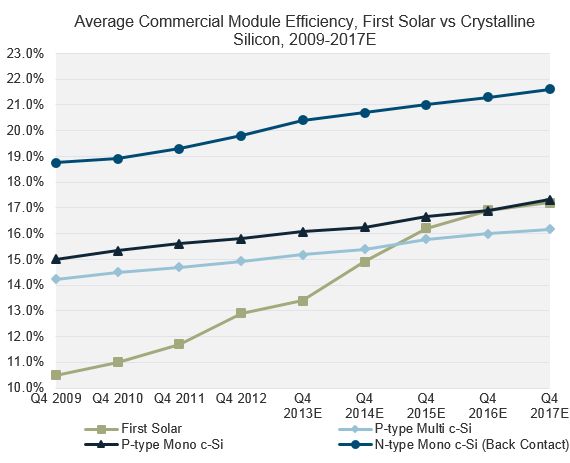Conventional wisdom holds that thin-film PV module efficiencies will always be below those of crystalline-silicon technologies. That has been the case to this day.
However, according to GTM Research's newly launched monthly data service PV Pulse, successful execution of First Solar's ambitious roadmap for its thin-film cadmium-telluride (CdTe) technology could see it surpassing standard multicrystalline silicon (c-Si) module efficiencies by the end of 2015.
As the April 2014 edition of the Pulse shows, current average commercial module efficiencies for multi c-Si modules at the end of 2013 ranged from 15.0 percent to 15.2 percent, almost 2 percent higher than First Solar's fleet average efficiency of 13.4 percent. By the end of 2015, however, First Solar's roadmap sees average efficiencies of 16.2 percent, compared to 15.8 percent for multi c-Si.

Source: GTM Research PV Pulse, April 2014
By the end of 2017, First Solar is targeting average efficiency of 17.2 percent, which would place it on about an equal footing with best-in-class P-type mono c-Si technology. The goal for its best manufacturing line is even higher, at 18.5 percent. This would still place First Solar a fair bit behind industry leader SunPower, whose proprietary n-type back-contact technology already drives module efficiencies of over 20 percent and is targeting best-line commercial module efficiency of 23 percent by the end of 2015.
"First Solar's updated module efficiency roadmap is the fulcrum upon which successful execution of its aggressive module and system cost targets rests, since both module and BOS costs are highly influenced by efficiency improvements. While there is certainly a degree of execution risk to these ambitious targets, there is reason to be optimistic, given that the company has a consistent history of beating expectations on the technology front," said Shyam Mehta, Lead Upstream Analyst at GTM Research.
Check out GTM Research's PV Pulse for more insights on the solar industry.



